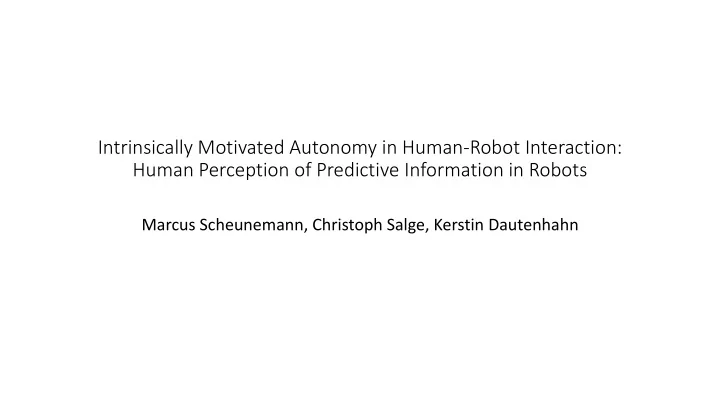

Intrinsically Motivated Autonomy in Human-Robot Interaction: Human Perception of Predictive Information in Robots Marcus Scheunemann, Christoph Salge, Kerstin Dautenhahn
Marcus Scheunemann in transit to RoboCup2019
Autonomous robots able to sustain interaction. Motivation
Intrinsic Motivation to Intrinsic Motivations Idea generate robot behaviour. … related to core elements of agency. Test Intrinsic Motivation in HRI context. Usual properties: • Robustness General Hypothesis: • Task-Independence • Increased markers for • Semantic Independence agency and other • Universality lifelike properties. • Leading to more interest in interaction.
Predictive Information Maximise mutual information between your past and future sensors. Conceptually: Control your own future while also experiencing a diversity of sensor states. • Playful behaviour (human perception) • Sensitive to Embodiment • Reactive to outside stimuli Implementation follows: • Applicable to range of robots Martius, G., Der, R., Ay, N.: Information driven self-organization of complex robotic Existing application to ball-like robot (in simulation) behaviors. PLoS one 8(5), 1 – 14 (2013).
• Sphero BB8 • Motors: • 2 servo-wheels inside the ball • Sensors: • 3 DOF accelerometer • 3 DOF gyroscope • Servo position and speed Our Robot
Conditions to Compare ADA: REA: Robot controlled by Baseline: • Random neural network • Human Controller that gets updated with • Reactive Controller preditive information maximising • Neural network, preadapted, but learning rule. not adapting during trial.
Experimental Setup Order REA, ADA randomized. Questionnaires after each condition. 16 participants, 5 female, 11 male.
Experimental Setup Interaction area with obstacles. • Open towards the participant. • Participants encourage to keep robot from falling. • Robot can be touched, which is demonstrated. Trials last for 5 minutes.
Questionnaires Godspeed: Open Questions: • Anthropomorphism • Animacy (1) Can you describe the different behaviours of the robot? Did the robot • Likeability have any particular strategy for • Perceived Intelligence exploring? • Perceived Safety (2) What were the best and/or worst aspects of the robot’s behaviour ? Robotic Social Attributes Scale (RoSAS), relatively new, 7 Likert Scale: • Warmth • Competence • Discomfort
• No significant p-values • Small sample size • Effect Size (r) • Perceived Intelligence, for REA • Warmth and Discomfort, for ADA Wilcoxon Signed Rank Test between REA and ADA Results
Upcoming Publications Successful follow up studies: New Task: Differentiate between the different robots. New Interaction Tool that allows for detection of human. Results for Discomfort and Warmth.
Acknowledgments C. Salge — Funded by Marie Sklodowska-Curie grant INTERCOGAM (705643). Marcus Scheunemann, UH marcus@mms.ai, @mmscheunemann Christoph Salge, UH c.salge@herts.ac.uk, @ChristophSalge Kerstin Dautenhahn, University of Waterloo
Recommend
More recommend